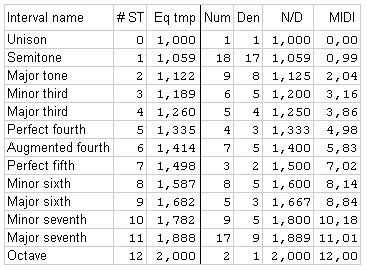 |
Frequency ratios
of the tone intervals within an octave.
At left the number of semitones in the intervals and corresponding
frequency ratios on the theoretical equal temperament scale.
At right close approximations to these in form of integer ratios
Num/Den, most as used with Just Temperament. The MIDI column
shows this converted back into equal temperament semitones, where the
decimals indicate the difference in cents.
E.g. a perfect fifth is 3:2=1.5, corresponding to 7 semitones plus 2
cents on the equal tempered scale. Similarly a 5:4 major third is 14
cents low, compared to equal temper.
|



































































